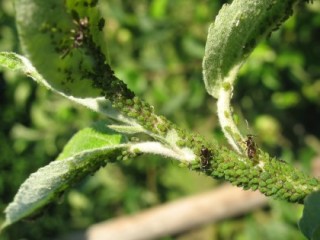
Green apple aphid is a common but minor pest of apple, which also attacks pear. It is most important on young trees. As the name implies it is bright green in colour and readily distinguished from other aphid pests of apple.
The life cycle starts when the aphid hatches in April at green cluster from overwintered eggs on the bark but the spring colonies that develop in shoot tips are of little importance.
Winged forms develop in summer, which migrate to the growing shoots of other apple trees.
Large, dense colonies develop along the lengths of the shoots from these migrants in summer and it is these that are damaging. The colonies have a strong distinctive smell.
Fruits in the vicinity of and below colonies become heavily contaminated with honeydew which becomes blackened by sooty mould and cast aphid skins. The colonies are usually attended by black ants.
The severity of infestation by green apple aphid should be determined in each orchard when pest assessments are done from late June to the end of August. Application of an insecticide to control green apple aphid should be considered if more than 10% of shoots have infestations causing leaf curling.
Control
Many insecticides are approved for control of aphids on apple but if aphids are the only pests that need to be controlled, flonicamid (Mainman) is the preferred choice in conventional orchards as it is selective and partially systemic.
- The neonicotinoid acetamiprid (Gazelle) is also highly effective. It will also control various other pests such as mussel scale.
- A full approval for spirotetramat (Batavia) on apples for the control of sucking insect pests will control green apple aphid, but growers may prefer to reserve its use for more difficult to control pests such as woolly aphid and rosy apple aphid. It must be applied after flowering and works best when pests are moving from brown wood to green tissue. It will prevent population build-up but does not offer pest ‘knockdown’.
- A recent EAMU for Flipper (fatty acids) has increased the available options should growers wish to reserve other insecticides for control of pests later in the season. It is known to complement the use of Batavia as it provides quick ‘knockdown’.
Use of synthetic pyrethroids, which are harmful to natural enemies, should be avoided.
Insecticides approved for use on apple which are recommended to control green apple aphid or offer some incidental control when applied to control other pests or diseases
| Choice of insecticides – efficacy factors | |||||
|---|---|---|---|---|---|
| Active ingredient | Trade name (examples) | Class | Selectivity | Approved for control of | Safety to Typhs |
| acetamiprid | Gazelle | neonicotinoid | broad-spectrum, systemic | Aphids | safe |
| deltamethrin | Decis Forte etc. | pyrethroid | broad spectrum | Aphids, apple sucker, capsids, caterpillars, codling & tortrix moths, sawfly | harmful |
| fatty acids | Flipper (EAMU 3419/19) | bioinsecticide | broad spectrum | Aphids, blossom weevil, two-spotted spider mite | unspecified but generally safe in IPDM programmes |
| flonicamid | Mainman | chlordotonal organ modulator | selective | Aphids and woolly aphid | safe |
| maltodextrin | Eradicoat Max | polysaccharide | broad spectrum | broad spectrum | harmful |
| spirotetramat | Batavia | tetramic acid derivative | selective | selective | unclassified |
| Choice of insecticides – Safety factors | |||||||
|---|---|---|---|---|---|---|---|
| Hazards | Harvest interval (days) | Max. no. sprays | Buffer zone width (m) | ||||
| Anticholin-esterase? | Humans | Fish & aquatic life | Bees | ||||
| acetamiprid | no | u | t | u | 14 | 2 | 20 |
| deltamethrin | no | h, i | ed | d | 7 | u | 50 |
| fatty acids | no | h, i | h | d | 0 | 8 | 20 |
| flonicamid | no | u | h | u | 21 | 3 | sm |
| maltodextrin | no | i | d | d | 0 | 20 | sm |
| spirotetramat | no | h, i | t | d | Start of ripening | 2 | 10 |
| h=harmful, i=irritant, d=dangerous, ed=extremely dangerous, c=closed cab required for air assisted sprayers, sm=statutory minimum of 5 m for broadcast airassisted sprayers u=uncategorised/unclassified/unspecified | |||||||
Control in organic orchards
Green apple aphid should be tolerated in established organic apple orchards because the pest only causes minor damage.
- Emphasis should be placed on cultural control measures such as the provision of artificial refuges for earwigs and lacewings and of flowering herbs in and around the orchard to encourage predatory insects.
- Where significant damage is being caused especially to young trees, as a last resort, localised, high volume sprays of fatty acids should be applied when damaging infestations develop on young trees in summer if necessary.
